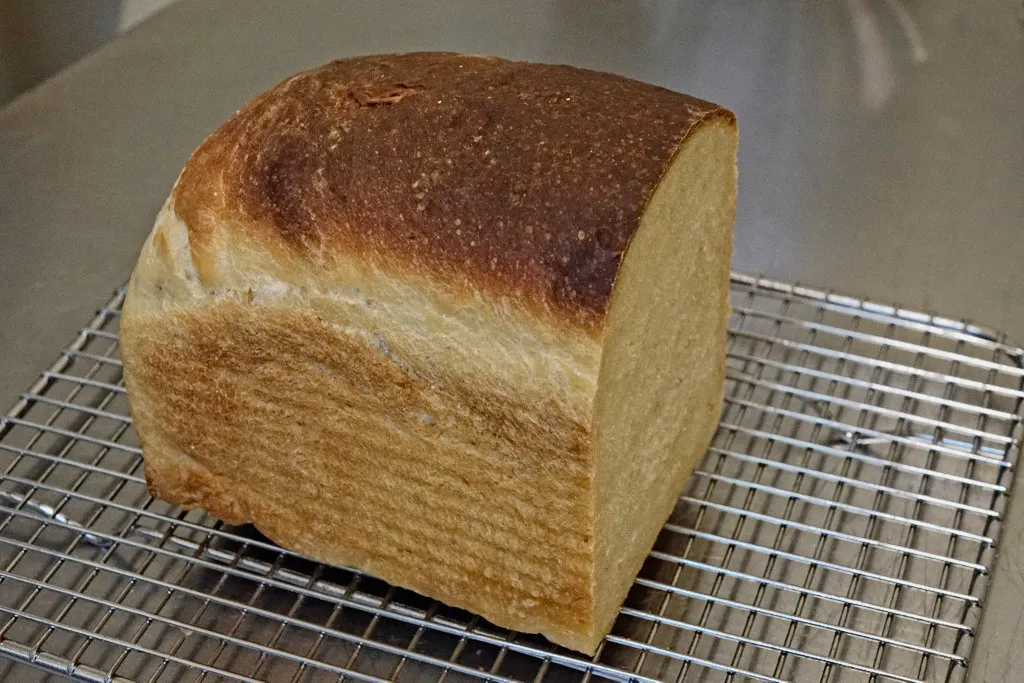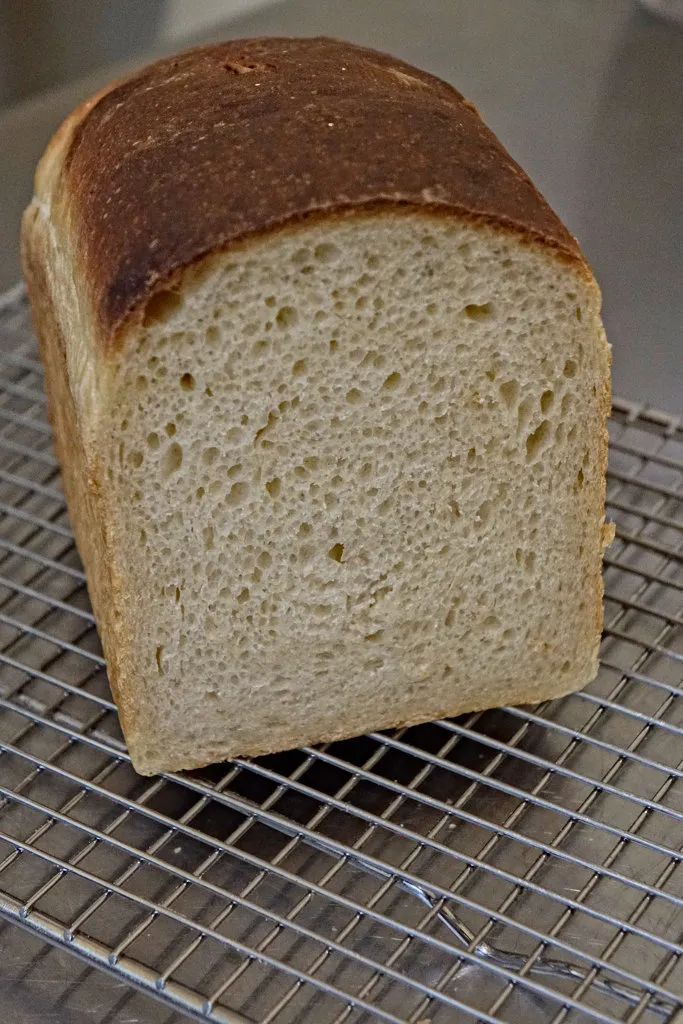
Many people post questions that amount to "Help -- can I change this?". The answer is almost always "Yes". In the interest of reassuring bakers who fear they might get something "wrong", I want to walk you through how I put together my most recent bake.
At almost the last minute I decided to make a pullman pan loaf of toasting bread in the "milk bread" style. This kind of enriched bread uses a premade gel of flour and water, or flour and milk. The gel holds more water and softens the crumb.
The first decision was that I didn't have any milk. So water it was instead. Next was how much flour to pre-gell. I have several recipes but didn't bother to look them up. Instead, I arbitrarily chose 15% of the flour. That would have been 67.5g and I used 70g, close enough.I knew I wanted to use 450g of flour, which might be a little small for the 4 X 4 X 9 inch Pullman pan but should eventually rise above the top. I decided to use twice as much water as flour by weight.
There are two standard gelling methods: tangzhong, in which you cook the flour in water or milk until it gets to around 150 deg F and gells; or yudane, in which you pour boiling water over the flour potion and stir. Yudane is quicker and easier so I went with it.
While that was cooling I got the other ingredients ready. I would have used 30% of the 450g of starter but I only had enough for 25%, so that was settled. These enriched breads usually include eggs, sugar, and oil or butter. I used 2 Tbsp of sugar because one didn't seem like enough but I don't like too much sugar. I used one egg.
For the butter, I wanted at least 5% by weight, so 23g. I had a 2 Tbsp end of a stick, a little more than the target, so I went with that.
I had in mind a hydration of 65% but with a yudane, eggs, and butter it's hard to be sure what will work well so I planned to withhold a little water and work my way upward as needed. For better gluten development it would probably be better to add the butter after the gluten was initially established. But I was working by hand and it's harder to incorporate the butter that way so I added it at the beginning as the last of the liquid ingredients during mixing. (Only half the butter melted in the microwave; the rest was very soft but not melted).
By the time I had added more water to hydrate all the flour and then added in the butter, the dough seemed wetter and softer than I had intended. But using a loaf pan makes it easier to deal with loose floppy dough since if need be the dough can just be scraped into the pan.
I included the 2% salt into the original mix, because I knew that would help strengthen the dough and an enriched dough like this can use the help.
After the mix came a half-hour rest. Then I kneaded the dough and did 40 "slap-an-folds", in which are gentler than the name sounds but good for stretching the dough out. I didn't have much of a plan about developing the strength of the dough but figured that I'd need at least two stretch-and-fold sessions. That turned out to be enough. In the first one, after half an hour, I did 40 more slap-and-folds. After another hour I did some coil folds in the bulk ferment tub. By this time the dough felt much better - less sticky and with more body. So no more handling until after the end of bulk.
The dough had doubled after about 6 hours. I stretched it out, rolled it up into a log, and got it into the Pullman pan. It filled the pan about half way up. After 1 1/2 hour of proofing it had only risen to about the 3/4 mark at best. But it was getting late and I had decided to bake the same day so I baked it.
The bake was without the lid in a 400 deg F oven without steam. After 20 minutes the top was pretty brown, so I turned the temperature setting down to 375 deg F and baked another 20 minutes. Sure enough the top didn't brown too much more.
The final loaf makes very fine toast. And it looks good, too. Here's the crumb:
I know this post is pretty long, but I wanted to show how I made up this bread as I went along. Sure, I had made similar breads before, but all the details were very much chosen on the fly as I went along.
The moral is - don't be shy, don't worry if you might deviate from some starting recipe. Small changes in the ingredients or techniques will normally result in only small changes of the bread. Exceptions are panettone and, maybe, breads with a high percentage of rye. Otherwise, with mostly wheat flour breads, don't worry!
TomP
What a lovely even crumb. It's nice to be able to be free from a recipe and see where it takes you.
I think your post deserves to be pinned in the noted bakes on the front page as it is an important lesson in baking with wonderful results.
Hope Floyd reads this message and agrees with me :)
Very nice, Tom!
Thank you, Abe! Very kind of you.
You are talking my kind of bread. Very nice.
Would you change the 450g quantity of flour for that pan size, or do you consider it perfect? It looks perfect to me--you don't really need the loaf any taller. I've got wonky-sized Pullman pans and always tinkering with the ideal dough weight.
I don't think I would change it. With this much dough, the loaf when baked has risen above the top of the pan but not quite everywhere. With the lid closed, the dough would have pressed against it in the middle but maybe not along the whole top. That would be OK, but I rather like the looks of the consistent rounding I got with this loaf (and another loaf I made earlier with the same amount of flour).
If it's not the perfect amount it's very close. The pan is the 4 X 4 X 9 one from USA Pans.
Hi,
Your post came to mind when I found myself without scales and baking in a newly acquired bread machine.
Only my flour had been measured out accurately. I threw in some butter at the end of the kneading.
I guessed on amount of starter, hydration, salt and diy and then fumbled through programming the bm.
After the final proof, I forgot to turn on the bake and so the final proof went 15 min too long.
But the 50-50 (AP:WW) turned out very well and even a first time tester found it soft and wants more!
You are right - wheat breads can take a lot of changes!
There you go! Thanks for sharing. I hope this thread will encourage a lot of people!